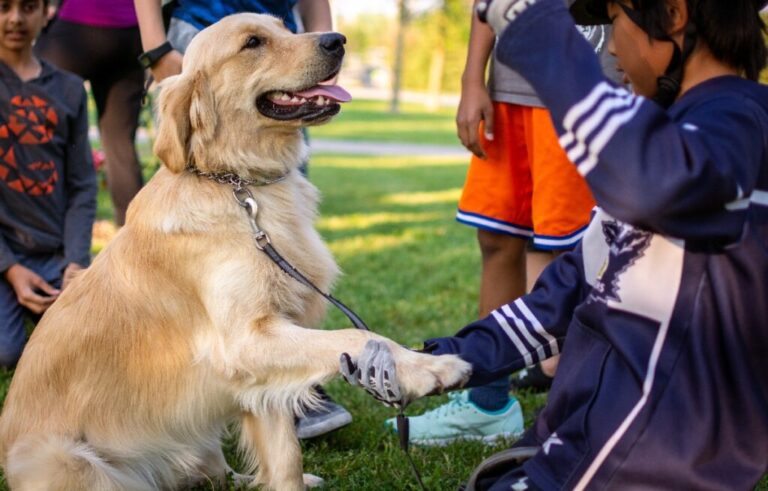Labrador Retriever Puppy Care 101: Your Comprehensive Guide
Labrador Retriever Basics
Before diving into the details of Labrador Retriever puppy care, let’s start with an introduction to Labrador Retrievers and an overview of their characteristics and temperament.
Introduction to Labrador Retrievers
Labrador Retrievers, often referred to as Labs, are a popular breed known for their friendly and outgoing nature. They originated in Newfoundland in the 1830s, where water dogs and hunting dogs were bred. Today, they are the most popular dog breed in the United States (MasterClass).
Labrador Retrievers are medium to large-sized dogs with a sturdy build. They have a distinctive coat that is dense, short, and water-resistant. Labs come in three main colors: yellow, black, and chocolate. They are highly versatile and excel in various roles, including as family pets, service dogs, therapy dogs, and working dogs.
Characteristics and Temperament
Labrador Retrievers have a reputation for being friendly, outgoing, and eager to please. They are known for their gentle and patient nature, making them great companions for families, individuals, and other pets. Labs are generally good with children and tend to get along well with other dogs.
These dogs are intelligent and adaptable, which makes them quick learners and suitable for various tasks and training purposes. They are often employed as search and rescue dogs, guide dogs for the blind, and assistance dogs for individuals with disabilities.
Labrador Retrievers have a high energy level and require regular exercise to maintain their physical and mental well-being. They enjoy activities such as swimming, retrieving, and playing fetch. It’s important to provide them with ample exercise and mental stimulation to prevent boredom and behavioral issues.
While Labs are generally friendly and sociable, early socialization is crucial to ensure they grow into well-rounded and well-behaved adults. Exposing them to various people, animals, environments, and experiences from a young age helps them develop into confident and well-adjusted dogs. For more information on socializing your Labrador Retriever, check out our article on socializing your Labrador Retriever.
Understanding the characteristics and temperament of Labrador Retrievers is essential for providing them with the care and environment they need to thrive. In the following sections, we will delve into various aspects of Labrador Retriever puppy care, including socialization, training, feeding, exercise, and healthcare.
Caring for Your Labrador Retriever Puppy
When it comes to caring for your Labrador Retriever puppy, there are several essential aspects to consider. These include socialization and training, feeding and nutrition, and exercise and mental stimulation. By focusing on these areas, you can ensure that your Labrador Retriever puppy grows into a happy and healthy adult dog.
Socialization and Training
Socialization plays a vital role in the development of your Labrador Retriever puppy. Early socialization helps them become well-adjusted, confident dogs. Introduce your puppy to various people, environments, and other animals to promote their social skills and build positive associations. Gradually expose them to different situations, sights, and sounds to help prevent fear and anxiety later in life. For more information on socializing your Labrador Retriever, check out our article on socializing your Labrador Retriever.
Training is another crucial aspect of caring for your Labrador Retriever puppy. Start training as soon as they arrive home to establish good behavior and obedience. Utilize positive reinforcement techniques, such as rewards and praise, to encourage desired behaviors. Basic commands like sit, stay, and come should be taught consistently and gradually built upon as your puppy grows. For a comprehensive guide on training Labrador Retriever puppies, refer to our article on training tips for Labrador Retrievers.
Feeding and Nutrition
Proper nutrition is essential for the healthy growth and development of your Labrador Retriever puppy. Choose a high-quality puppy food that is specifically formulated for large breeds. Look for a balanced diet that contains the right proportions of proteins, fats, carbohydrates, vitamins, and minerals. The food should ideally have a protein content of at least 22% to support their growth (Snowy Pines White Labs).
Portion control is crucial to prevent overfeeding and obesity, which Labrador Retrievers are prone to. Follow the feeding guidelines provided by the food manufacturer based on your puppy’s age, weight, and activity level. Avoid free-feeding and establish a regular feeding schedule. Treats should be given sparingly and used as rewards during training sessions. To learn more about the best diet and nutrition for Labrador Retrievers, refer to our article on best diet and nutrition for Labrador health.
Exercise and Mental Stimulation
Labrador Retrievers are an active breed that requires regular exercise to maintain a healthy weight and prevent behavioral issues. Provide daily exercise that includes both physical activity and mental stimulation. Aim for at least 30-60 minutes of exercise each day, which can include walks, interactive play, and games. Mental stimulation through training sessions, puzzle toys, and scent trails is also important to keep your Labrador Retriever puppy engaged and prevent boredom.
Leash walking is an excellent exercise for Labrador Retrievers, as it provides both physical and mental stimulation. Use positive reinforcement techniques and rewards to make leash training a positive experience for your puppy. Interactive play, such as fetch or tug-of-war, is another great way to exercise your Labrador Retriever puppy. Incorporating puzzle toys and teaching them new tricks can help keep their minds sharp and active.
Remember to gradually increase exercise intensity as your puppy grows, and always consider their age, health, and any specific recommendations from your veterinarian. For more information on exercise guidelines for Labrador Retrievers, refer to our article on exercise needs of Labrador Retrievers.
By focusing on socialization and training, feeding and nutrition, and exercise and mental stimulation, you can provide your Labrador Retriever puppy with the care and attention they need to thrive. Remember to consult with your veterinarian for personalized advice and recommendations specific to your puppy’s needs. With proper care and love, your Labrador Retriever puppy will grow into a cherished companion for years to come.
Common Health Issues in Labrador Retrievers
Labrador Retrievers are generally healthy dogs, but like any breed, they are susceptible to certain health issues. It’s important to be aware of these conditions so that you can provide the necessary care and early intervention. Here are some common health issues that Labrador Retrievers may experience:
Obesity and Weight Management
Labradors are known for their hearty appetites and love for food, which can make them prone to obesity. Obesity in Labradors can lead to various health problems, including arthritis, diabetes, and heart disease. It’s crucial to monitor your Labrador’s weight and ensure they maintain a healthy body condition.
Proper nutrition and portion control are key when it comes to weight management in Labradors. A balanced diet that meets their nutritional needs, along with appropriate portion sizes, can help prevent overfeeding and weight gain. Avoid giving in to their pleading eyes for extra treats, as excess calories can quickly contribute to obesity. For more information on providing the best diet and nutrition for your Labrador’s health, visit our article on best diet and nutrition for Labrador health.
Hip and Elbow Dysplasia
Hip and elbow dysplasia are common orthopedic conditions in Labrador Retrievers. Dysplasia refers to abnormal development or formation of the joints, which can result in arthritis, pain, and lameness. It is a genetic condition that can be influenced by factors such as rapid growth, excessive weight, and genetics.
Regular exercise and maintaining a healthy weight are essential for managing hip and elbow dysplasia in Labradors. Providing low-impact exercise and avoiding activities that put excessive strain on their joints can help reduce the risk of complications. Joint supplements and medications may also be recommended by your veterinarian to manage pain and inflammation. Regular check-ups and X-rays can help detect any signs of dysplasia early on, allowing for prompt intervention.
Ear Infections and Allergies
Labradors have floppy ears that can trap moisture and debris, making them prone to ear infections. Bacterial or yeast overgrowth can occur, leading to inflammation, discomfort, and recurrent infections. Regular ear cleaning and monitoring are essential to prevent and manage ear infections in Labradors.
When cleaning your Labrador’s ears, it’s important to use a gentle ear cleaner recommended by your veterinarian. Avoid using cotton swabs or any sharp objects that can damage the ear canal. Regularly check their ears for signs of redness, discharge, or a foul odor. If you notice any abnormalities, consult your veterinarian for appropriate treatment.
In addition to ear infections, Labradors can also develop allergies. Allergies may manifest as skin irritations, itching, or digestive issues. If you suspect your Labrador has allergies, consult your veterinarian for a proper diagnosis and treatment plan.
Chocolate Toxicity and Progressive Retinal Atrophy
Labradors have a genetic predisposition for enjoying food, which makes them particularly vulnerable to chocolate toxicity. Chocolate contains theobromine, a compound that is toxic to dogs. Ingestion of chocolate can lead to symptoms such as vomiting, diarrhea, increased heart rate, and even seizures. It’s crucial to keep chocolate and other toxic foods out of your Labrador’s reach to prevent poisoning. If you suspect your Labrador has ingested chocolate, contact your veterinarian immediately.
Another health issue that can affect Labradors is progressive retinal atrophy (PRA). PRA is a degenerative eye disease that leads to progressive vision loss and eventual blindness. Regular eye examinations by a veterinary ophthalmologist can help detect PRA early on. While there is no cure for PRA, early detection allows for appropriate management and accommodations to ensure your Labrador’s quality of life.
By being aware of these common health issues in Labrador Retrievers, you can take proactive measures to provide the best care for your furry friend. Regular veterinary check-ups, a balanced diet, proper exercise, and preventive measures can help keep your Labrador healthy and happy for years to come. For more information on Labrador Retriever health issues and care, visit our article on Labrador Retriever health issues and care.
Feeding Your Labrador Retriever Puppy
Proper nutrition is key to the healthy growth and development of your Labrador Retriever puppy. In this section, we will explore important considerations when it comes to feeding your puppy, including a balanced diet for growth and development, portion control to avoid overfeeding, and the importance of avoiding human food and allergens.
Balanced Diet for Growth and Development
Feeding your Labrador Retriever puppy a well-balanced diet is crucial for their growth and development. Puppies have unique nutritional needs, and it’s important to provide them with a diet that supports their rapid growth. A high-quality puppy food formulated specifically for large breed puppies is recommended.
These puppy foods are designed to provide the right balance of nutrients, including protein, fats, carbohydrates, vitamins, and minerals. Protein is particularly important for muscle development, while fats provide energy and support the development of healthy skin and coat. Carbohydrates are a source of energy, while vitamins and minerals are essential for overall health and well-being.
Consulting with your veterinarian can help you determine the appropriate type and amount of food to feed your Labrador Retriever puppy based on their age, weight, and activity level. They can also provide guidance on any specific dietary requirements your puppy may have.
Portion Control and Avoiding Overfeeding
Labrador Retrievers are known for their love of food, which can make portion control challenging. However, it’s crucial to avoid overfeeding your puppy to prevent obesity and associated health problems.
Puppies should be fed multiple times a day to support their rapid growth and development. A feeding schedule can help regulate their intake and prevent overfeeding. Dividing their daily food allowance into several smaller meals throughout the day ensures they receive the nutrition they need without overindulging (ProDog Raw).
Monitoring your puppy’s weight is essential to ensure they are growing at a healthy rate. If you notice your puppy becoming overweight, consult with your veterinarian to adjust their portion sizes accordingly. It’s important to strike the right balance between providing enough food to support their growth without overfeeding.
Avoiding Human Food and Allergens
While it may be tempting to share your meals with your Labrador Retriever puppy, it’s essential to avoid giving them human food. Human food can upset their stomach and lead to health issues. Some foods, such as chocolate, grapes, and onions, are toxic to dogs and should never be given to them.
Additionally, Labrador Retrievers, like many other breeds, can be prone to food allergies and sensitivities. Therefore, it’s important to avoid feeding your puppy foods that may trigger an allergic reaction. Common allergens for dogs include wheat, corn, soy, and certain protein sources such as beef or chicken.
When introducing new foods or treats to your Labrador Retriever puppy, do so gradually and monitor for any signs of allergic reactions, such as itching, gastrointestinal upset, or skin irritations. If you suspect your puppy has food allergies, consult with your veterinarian for guidance on an appropriate diet.
By providing a balanced diet, practicing portion control, and avoiding human food and potential allergens, you can ensure that your Labrador Retriever puppy receives the nutrition they need for healthy growth and development. Remember to consult with your veterinarian for personalized feeding recommendations based on your puppy’s specific needs.
Proper Exercise for Labrador Retriever Puppies
As a Labrador Retriever puppy owner, it’s important to provide them with proper exercise to ensure their physical and mental well-being. Labrador Retrievers are known for their high energy levels, so meeting their exercise needs is crucial to keep them healthy, happy, and well-behaved.
Daily Exercise Requirements
Labrador Retriever puppies require at least two hours of good exercise each day to keep them physically and mentally stimulated (PitPat). Regular exercise helps prevent behavioral issues such as destructiveness, hyperactivity, and even aggression (PitPat).
When planning your puppy’s exercise routine, it’s important to keep in mind that their growing bones and joints are still developing. Avoid high-impact activities that may strain their developing bodies. Instead, focus on low-impact exercises and gradually increase the intensity as they grow older.
Leash Walking and Positive Reinforcement
Leash walking is an excellent exercise for Labrador Retriever puppies. It allows them to explore their surroundings while providing you with control and ensuring their safety. Start with short walks and gradually increase the duration as your puppy grows. Use positive reinforcement techniques, such as treats and praise, to encourage good leash manners and behavior. Leash walking also provides an opportunity for socialization, allowing your puppy to meet other dogs and people in a controlled environment.
Mental Stimulation and Interactive Play
In addition to physical exercise, Labrador Retriever puppies require mental stimulation to keep their minds engaged and prevent boredom. Incorporate interactive play sessions into their daily routine. Engage them in games of fetch, hide-and-seek, or puzzle toys that challenge their problem-solving skills. These activities provide mental stimulation while also satisfying their natural retrieving instincts.
Training sessions are another way to provide mental stimulation for your Labrador Retriever puppy. Teach them basic obedience commands and engage in positive reinforcement training methods. This not only stimulates their minds but also strengthens the bond between you and your puppy. For training tips specific to Labrador Retrievers, check out our article on training tips for Labrador Retrievers.
Remember, maintaining a healthy weight is crucial for Labrador Retrievers, especially during their growth stages. Proper exercise and mental stimulation help in achieving and maintaining a healthy weight, which contributes to their overall well-being and reduces the risk of obesity-related health issues. For more information on Labrador Retriever health issues and care, visit our article on Labrador Retriever health issues and care.
By providing your Labrador Retriever puppy with the appropriate amount of exercise and mental stimulation, you can help them lead a happy, active, and well-rounded life. Tailor their exercise routine to their age and physical abilities, and always monitor their behavior and energy levels to ensure they are getting the exercise they need.
Regular Veterinary Care for Labrador Retrievers
To ensure the overall health and well-being of your Labrador Retriever puppy, regular veterinary care is essential. Regular vet check-ups, vaccinations, and preventative care are crucial components of responsible pet ownership. In this section, we will discuss the importance of vet check-ups, vaccinations, and monitoring weight and growth for your Labrador Retriever.
Importance of Vet Check-ups
Regular vet check-ups are vital for monitoring your Labrador Retriever puppy’s health and detecting any potential issues early on. During these check-ups, the veterinarian will perform a thorough examination, assess your puppy’s growth, and address any concerns you may have. These visits allow the vet to catch and treat any health problems before they escalate. It is recommended to schedule check-ups at least once a year, or more frequently as advised by your veterinarian.
Vaccinations and Preventative Care
Vaccinations play a crucial role in protecting your Labrador Retriever puppy from various infectious diseases. Your veterinarian will provide a vaccination schedule tailored to your puppy’s needs. Common vaccinations for Labradors include those for rabies, distemper, parvovirus, and canine hepatitis. It’s important to follow the recommended vaccination schedule to ensure your puppy is adequately protected.
In addition to vaccinations, preventative care is essential for your Labrador Retriever’s well-being. This includes regular deworming to protect against internal parasites, such as roundworms and hookworms. Your veterinarian may also recommend preventive medications for fleas, ticks, and heartworms, depending on your location and the prevalent risks in your area.
Monitoring Weight and Growth
Labrador Retrievers are prone to certain health issues, such as obesity and hip and elbow dysplasia. Monitoring your puppy’s weight and growth is crucial to prevent these problems. Labradors have a higher risk of obesity compared to other breeds, which can lead to various health issues, including diabetes, joint problems, and a reduced lifespan. Maintaining a healthy weight through proper diet and exercise is essential for their overall well-being. Your veterinarian can provide guidance on appropriate feeding and portion control to help you ensure your Labrador Retriever maintains a healthy weight.
Labradors are also susceptible to hip and elbow dysplasia, which can lead to arthritis, pain, and lameness. Regular monitoring of your puppy’s growth and joint development can help detect any signs of dysplasia early on. If necessary, your veterinarian may recommend further diagnostic tests, such as X-rays, to assess the condition of the joints.
By prioritizing regular veterinary care, including check-ups, vaccinations, and weight and growth monitoring, you can help ensure that your Labrador Retriever puppy stays healthy and happy throughout their life. Your veterinarian is your best resource for personalized advice and guidance on the specific needs of your Labrador Retriever.
Origin and History of Labrador Retrievers
Labrador Retrievers have a rich history that traces back to their origins in Newfoundland, Canada. These dogs were originally bred in the 1830s as working dogs for fishermen. Their purpose was to assist in retrieving fish that escaped from nets and to pull in fishing lines through the icy waters of the North Atlantic (MasterClass).
Newfoundland Origins and Purpose
The Labrador Retriever’s beginnings can be tied to the province of Newfoundland in Canada (PetMD). Working alongside fishermen, they demonstrated their exceptional swimming abilities, retrieving skills, and strong work ethic. The dogs were well-suited to the demanding tasks of retrieving fish and pulling nets through cold waters, even in adverse weather conditions (American Kennel Club).
Labrador Retrievers quickly became indispensable to the fishermen of Newfoundland. Their friendly and gentle nature, combined with their intelligence and versatility, made them popular not only as working dogs but also as companions and family pets (PetGuide). The breed’s ability to adapt to various tasks, including retrieving game during hunting expeditions, further enhanced their reputation as versatile and reliable dogs (Petful).
Popularity in the United States
Today, Labrador Retrievers are not only renowned for their history but also for their popularity as family pets in the United States. They have consistently ranked as the most popular dog breed in the country, according to American Kennel Club registration statistics (MasterClass).
Their friendly and outgoing nature, combined with their intelligence and trainability, make them great companions for individuals and families alike. Labrador Retrievers have a natural affinity for people, especially children, and they often excel in activities such as obedience trials, agility competitions, and therapy work (ProDog Raw).
Understanding the history and origins of Labrador Retrievers provides valuable insight into the breed’s characteristics and temperament. Whether you are considering adding a Labrador Retriever to your family or are already a proud owner, appreciating their rich heritage can deepen your connection with these remarkable dogs.
Training Labrador Retriever Puppies
When bringing home a Labrador Retriever puppy, training should begin right away to ensure a well-behaved and obedient companion. Early socialization is crucial for their development, and puppies should be exposed to various people, environments, and other animals to promote their social skills and confidence (AKC). In this section, we will explore training during the first year and cover some obedience and behavior basics for your Labrador Retriever puppy.
Training During the First Year
The first year of a Labrador Retriever puppy’s life is a critical period for training and establishing good habits. Start by teaching basic commands such as “sit,” “stay,” and “come.” Consistency is key during this stage, and positive reinforcement techniques work best. Reward your puppy with treats, praise, and play when they follow commands correctly.
It’s also important to establish a regular routine for your puppy, including consistent feeding times, potty breaks, and exercise sessions. This routine will help them understand expectations and reduce behavioral issues. Remember that Labrador Retrievers are intelligent and eager to please, so using positive reinforcement and rewards will motivate them to learn quickly.
Alongside basic commands, leash training is another essential aspect of training during the first year. Introduce your puppy to a leash early on and gradually increase the duration and complexity of walks. Always use positive reinforcement and reward your puppy for walking calmly beside you. This will help prevent pulling and establish good leash manners.
Obedience and Behavior Basics
In addition to basic commands, it’s important to address common behavior issues that Labrador Retriever puppies may exhibit. Labrador Retrievers are known for their energy and enthusiasm, so it’s crucial to provide them with ample exercise and mental stimulation (PitPat). This will help prevent behavioral problems like destructiveness, hyperactivity, and even aggression.
To discourage unwanted behaviors, such as chewing or jumping, redirect your puppy’s attention to appropriate toys or activities. Labrador Retrievers are renowned chewers, so ensure they have plenty of chew toys to satisfy their natural urge to chew.
Consistency and positive reinforcement are key when addressing behavior issues. Instead of scolding or punishing your puppy for misbehavior, redirect their attention and reward them for appropriate behavior. They will quickly learn what is expected of them and respond positively to your guidance.
Enrolling your Labrador Retriever puppy in obedience classes can also be beneficial. These classes provide structured training sessions and allow your puppy to socialize with other dogs, helping them develop good social skills and manners. The guidance of a professional trainer can be invaluable in building a strong foundation for obedience training.
Remember, training is an ongoing process that requires patience, consistency, and a positive attitude. With proper training and guidance during the first year, your Labrador Retriever puppy will grow into a well-behaved and obedient companion.
To learn more about Labrador Retriever care, check out our articles on common misconceptions about Labrador Retrievers, training tips for Labrador Retrievers, and the importance of regular health check-ups for Labradors.
Exercise Guidelines for Labrador Retrievers
Labrador Retrievers are known for their high energy levels, and providing them with regular exercise is essential for their overall well-being. In this section, we will discuss the recommended exercise guidelines for Labrador Retriever puppies.
Daily Exercise Recommendations
To keep your Labrador Retriever puppy happy and healthy, it is important to provide them with daily exercise. Puppies should start getting accustomed to moderate exercise around the age of four months, as recommended by Embark Pets. A general rule of thumb is to aim for a 5-minute walk for each month of age, twice a day. For example, a 4-month-old puppy would benefit from a 20-minute walk, twice a day.
As your puppy grows, you can gradually increase the duration and intensity of exercise. Pay attention to their behavior and energy levels to determine if they need more or less exercise. It’s important to find a balance that provides enough physical activity without overexerting your puppy.
Interactive Play and Mental Stimulation
In addition to physical exercise, engaging in interactive play is an excellent way to exercise your Labrador Retriever puppy both mentally and physically. Interactive play helps stimulate their minds and provides an outlet for their energy. Activities like playing fetch, running, and incorporating puzzle toys can keep them entertained and mentally stimulated.
Consider varying the types of toys you use during playtime to keep your Labrador Retriever puppy engaged. Puzzle toys that dispense treats or require problem-solving can be particularly beneficial for their mental development. These toys provide a fun challenge while rewarding them for their efforts.
Swimming as a Low-Impact Exercise
Swimming is a fantastic low-impact exercise for Labrador Retrievers, as they are natural swimmers. It is a great way to provide exercise while minimizing stress on their joints. Swimming can be particularly beneficial for puppies with joint issues or older Labs who may find walking or running difficult. If you have access to a safe swimming area, consider incorporating swimming sessions into your Labrador Retriever puppy’s exercise routine.
When introducing your puppy to swimming, always prioritize their safety. Start in shallow water and gradually increase the depth as they become more comfortable. Keep a close eye on them and provide constant supervision to ensure they stay safe in the water.
Remember, each Labrador Retriever puppy is unique, and their exercise needs may vary. It is crucial to consult with a veterinarian or a professional dog trainer for specific exercise recommendations tailored to your Labrador Retriever puppy’s age, health, and individual needs. They can guide you in developing an exercise routine that will keep your puppy happy, healthy, and well-exercised.
For more information on Labrador Retriever puppy care, be sure to check out our comprehensive guide on Labrador Retriever Puppy Care 101.






